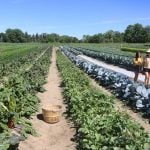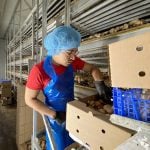Sow stalls | Producers lack incentives to adopt changes, says official
LOUISVILLE, Ky. — British pig farmers abandoned their sow stalls in 1999 but struggle to remain competitive with the rest of Europe, where adoption of new welfare rules has been hit and miss.
Eighteen members of the European Union had said they would be compliant with new pig welfare directives by January 2013, but only 10 have come online, said Zoe Davies, general manager of the National Pig Association in the United Kingdom.
The European Commission has started legal proceedings but this is a long and ineffective process, she said April 17 via telephone to the National Institute of Animal Agriculture meeting in Louisville.
Read Also

Grain farming’s hard times expected to continue
Rabobank says it will be two more years before North American grain farmers achieve break-even due to “monster” supplies and “sticky” crop input prices.
“It is a big issue for us,” she told the conference’s animal welfare session.
“We have been trying to compete for 14 years and they have had plenty of time and they are still not there.”
Producers were supposed to convert their barns to remove the crates and provide more space with improved flooring, as well as change painful procedures such as tail docking.
Davies said grant money is available to convert barns, but there was no real incentive for producers to comply before the deadline.
Several countries warned the commission that their producers would go out of business if they were forced to mandate the new rules.
“Spain and Italy have managed to convince the commission they are compliant, but we know they are not,” she said.
France did not submit information to the commission until last year, and Davies said there was no indication when it might be compliant.
She said the U.K. industry has struggled for the last 20 years, declining from 772,000 sows to 400,000. It now produces 4.2 million pigs, mostly in eastern England.
The industry faced classical swine fever in 2000 and foot-and-mouth disease in 2001.
“We never really recovered,” she said.
“Once the decline had happened, getting back the export markets never really happened.”
More pork is coming in from the Netherlands and Denmark and possibly countries where welfare systems have not been changed.
“Retailers have the power and if they don’t act responsibly, we have no hope,” she said.
“They need to know where their pork is coming from, and it needs to come from legal farms.”
The U.K. has 10,900 pig farms, but only 2,000 are quality assured under the National Farmers Union’s Red Tractor Assurance program. However, those farms account for 92 percent of production.
Half of the country’s sows live in straw based systems, 10 percent are in barns with partly slatted floors and the remainder are fully slated. About 40 percent of breeding sows are permanently housed outdoors, while most finishers are indoors. Sixty percent live in straw based barns.
The pigs must have an unobstructed floor area and toys.
“Innovation is ongoing, and there is all manner of toys that producers are providing for their pigs,” she said.
However, the public still sees problems with current management practices. People consider slatted floors barren and do not understand practices such as teeth removal and tail docking.
Teeth and tails are clipped to reduce problems with fighting and biting.
Davies said the pork industry is trying to work with welfare groups such as the Royal SPCA, Compassion in World Farming and EuroGroup for Animals, an umbrella group for 40 welfare organizations across Europe.
However, the British Pig Health and Welfare Council also doesn’t want to compromise producers’ ability to raise their animals and care for them.
The council is running large industry trials to assess the welfare of finishers and sows on 100 farms. Results will be incorporated into a new farm assurance scheme starting later this year.
She said welfare changes have been adopted, but there has been little payback for the U.K. pig industry.
Few producers have made any profit since 2010. They receive a premium from retailers because the pork is considered high welfare, but they face volatile feed costs, which account for 65 to 70 percent of the cost of production.
Market prices have also been unpredictable, and there is a limit to how much consumers will pay.
She said most of the pressure for change is coming from welfare lobby groups and retailers looking for a competitive edge.
Davies said the industry also faces criticism over antibiotic use. Animal rights groups tell consumers to eat less meat to save the environment and warn that eating meat causes cancer.
There have also been undercover exposes of some farms where practices were unacceptable.
“When they come out with this information, they make it sound like every farm is like this,” she said.
Davies said activist groups also publicly protest any time someone applies for a building application. They work with local residents to make it difficult to build new operations, citing complaints about flies, odour, dust, manure, disease that affects pigs and people and a general objection to “factory farms.”















